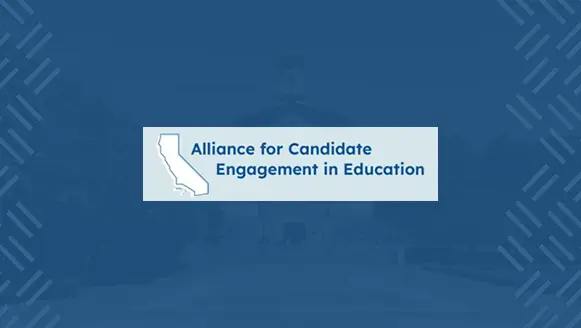Making Education a Priority in California’s
2026 Elections
Making Education a Priority in California’s
2026 Elections
California’s Students Deserve Bold Leadership & Real Solutions

A Critical Moment for California’s Future
In November 2026, California voters will elect a new governor, lieutenant governor, and superintendent of public instruction. Three leadership roles with profound influence over education policy, funding, and practice across the state. As the election cycle gains momentum, The Alliance for Candidate Engagement in Education, a coalition of nonpartisan 501 (c) (3) education, civil rights, and legal advocacy organizations, is coming together to ensure that education is front and center in the minds of every candidate.
Education Equity Issue Briefs
This set of briefing papers presents an Education Agenda for the next five years for California’s leaders and the public to consider.
An Education Equity Agenda for California
Modernizing Statewide Coordination
- California lacks a statewide coordinating body to align TK–12, higher education, and workforce systems, limiting progress toward shared goals and student success.
- Policy solutions include establishing a higher education coordinating entity with authority to advise state leaders, set strategic goals, and oversee funding, data, and accountability across systems.
- Coordinated governance would improve transfer pathways, close equity gaps, and ensure investments support college access, workforce preparation, and economic mobility for all Californians.
Diversifying California’s Educator Workforce: State Policy Solutions to Advance Equity and Excellence
- California’s teacher workforce lacks diversity, with systemic barriers limiting entry and retention for educators of color.
- Policy solutions include raising teacher pay, expanding affordable credentialing pathways, and supporting mentorship and inclusive school climates.
- Statewide coordination and data systems must be strengthened to track progress and guide investments in diversifying the educator pipeline.
Implementing Early Education Rate Reform: Fully Funding the Mixed-Delivery System of Early Learning and Care
Affordable, high-quality early learning is out of reach for many families. Reforming provider reimbursement rates is key to expanding access and improving quality.
- Most eligible children are not enrolled due to limited funding and access.
- Reimbursement rates don’t reflect the true cost of providing quality care.
- Low wages and unstable funding threaten the early learning workforce and system quality.
Improving Higher Education Affordability
- California’s financial aid system needs modernization to prioritize low-income students and cover full college costs, including housing, food, and transportation.
- Policy solutions include expanding Cal Grant and Middle Class Scholarship programs, increasing emergency aid, and investing in basic needs resources.
- Statewide coordination and outreach are essential to ensure equitable access to financial aid and student support services
Ensuring Adequate & Stable Funding for Public Education: Restoring California’s Leadership in Funding Public Education
- California ranks low in per-pupil spending despite its economic strength.
- Existing funding formulas improve equity but don’t guarantee adequacy.
- Long-term investment and new revenue strategies are needed to meet student needs.
Candidate Questionnaires

Education is an essential issue in California’s future, and voters deserve to know where candidates stand. We are inviting individuals running for governor, lieutenant governor, and superintendent of public instruction to respond to a set of nonpartisan questionnaires focused on key education topics.
These topics include:
- Early Education Rate Reform
- Adequate & Stable Funding for Public Education
- Diversifying the Educator Workforce
- Higher Education Affordability
- Statewide Coordination Across Education Systems
View unedited answers from candidates who chose to participate.








